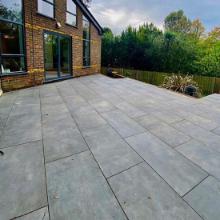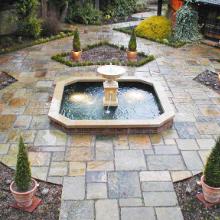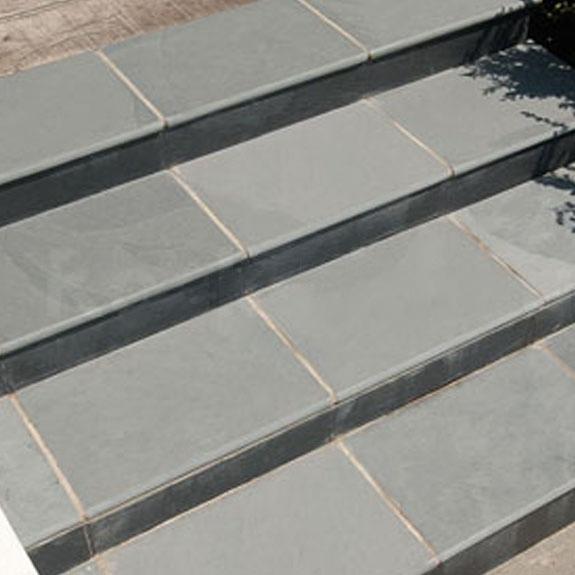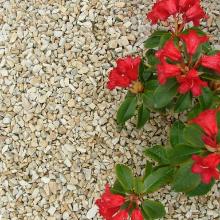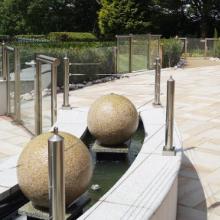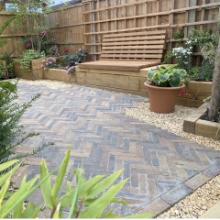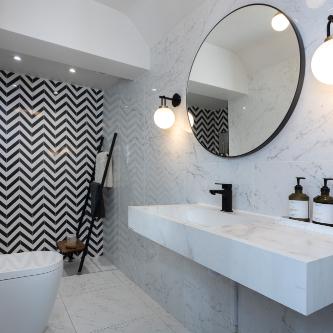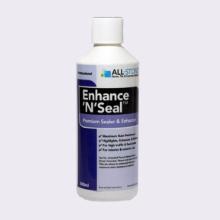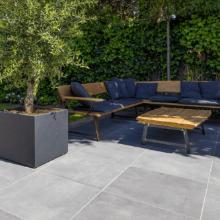For centuries, natural stone defined architecture and outdoor design. From ancient courtyards to modern patios, stone has offered authentic character and lasting performance. Now, porcelain paving has entered the market, reshaping expectations with engineered consistency, durability, and design freedom. So which material should you really choose — porcelain or natural stone?
A Market in Transition
There was a time when stone was the only choice for patios, driveways, and terraces. Sandstone, limestone, granite, and slate dominated the market. In the last two decades, porcelain has transformed the landscape. High-quality Italian and Spanish manufacturing now reproduces stone surfaces with stunning accuracy using advanced digital printing and pressing technology. The market is now balanced between tradition and innovation — stone remains the benchmark for authenticity, while porcelain sets the standard for engineered reliability.
How the Two Materials Are Made
Natural stone is quarried and cut, each piece unique and shaped by nature. Porcelain is made from refined clays, feldspar, and quartz, fired at around 1,200°C until vitrified. Modern porcelain production uses robotics and digital sensors to control moisture, temperature, and pressure, ensuring exceptional uniformity. Stone varies in tone, thickness, and texture — characteristics many still see as its greatest strength.
Strength, Durability, and Weather Resistance
From an engineering standpoint, porcelain is the more consistent performer. It absorbs less than 0.5% water, making it immune to frost and staining. Dense stones like granite or basalt perform similarly, while softer stones like limestone or sandstone can absorb more moisture. Porcelain that imitates limestone usually outperforms real limestone, while porcelain that resembles granite or basalt performs about the same as the real thing.
Appearance and Authenticity
Natural stone offers authenticity that no printed surface can truly equal — fossil markings, mineral inclusions, and the way it ages over time. Porcelain, by contrast, is precise and stable, with colour and texture that remain unchanged year after year. Top-tier porcelain from Italy and Spain achieves an uncanny realism, both visually and to the touch, often indistinguishable from natural stone.
Slip Resistance and Safety
Porcelain paving is rated R11 or R12 for outdoor slip resistance, providing reliable grip even when wet. Stone achieves slip resistance through texture — sawn, flamed, or riven finishes — though weathering can reduce its effectiveness. Porcelain’s consistency ensures predictable performance, while stone’s natural variation gives unique visual interest.
Maintenance and Longevity
Porcelain requires minimal maintenance: it does not need sealing and resists stains, moss, and frost. Stone demands more care, especially softer types, but rewards it with a developing patina and depth of character. Both materials last decades, but porcelain offers stability with less intervention, while stone matures gracefully under attentive maintenance.
Environmental Considerations
Porcelain production is energy-intensive, though leading manufacturers now use solar power and cogeneration to offset emissions. Stone requires less processing but quarrying and long-distance transport can increase its environmental impact. Locally sourced stone is often a sustainable choice; imported stone may have higher embodied energy than European porcelain.
Installation and Practicality
Porcelain’s accuracy simplifies installation but requires a bonding slurry for adhesion due to its low porosity. Stone is more forgiving to lay but demands skilled levelling because of slight variations in thickness. Porcelain suits speed and precision; stone appeals to craftsmanship and tradition.
Cost Comparison
Entry-level porcelain competes with imported sandstone, mid- to high-range porcelain competes with premium limestone or granite. However, nothing truly competes with the very best natural stones such as Yorkstone or Italian porphyry, which remain unmatched in quality and prestige.
The Balanced View
The rise of porcelain doesn’t replace stone — it complements it. Porcelain offers superior
consistency and low maintenance, while stone delivers authenticity and individuality. Stone
competes with mid- to high-end porcelain, but nothing competes with the best stone. Porcelain that looks like limestone often outperforms it, while those that mimic granite, basalt, or porphyry perform about the same. Both materials have earned their place — the choice depends on what you value most: perfection or personality
